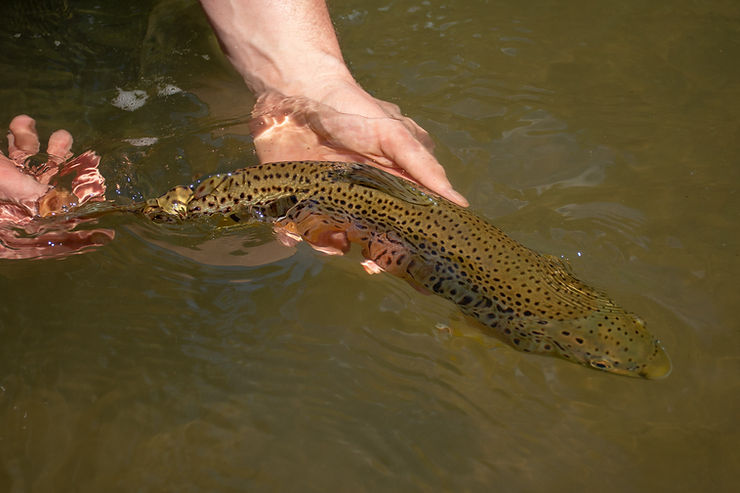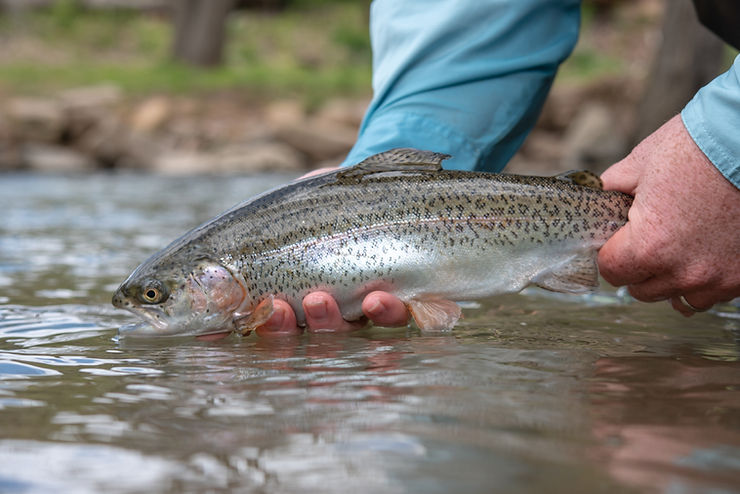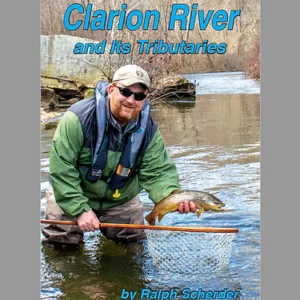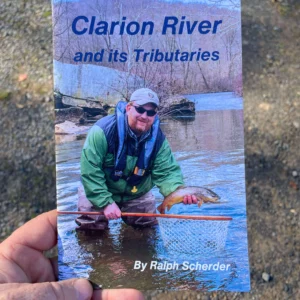PA’s Forgotten Limestoner: Yellow Creek, Bedford County

Yellow Creek is a 20.9-mile tributary to the Raystown Branch Juniata River. Yellow Creek rises near the town of Woodbury in Bedford County, PA, and flows in a southeastern direction toward the town of Loysburg.
In its beginnings, Yellow Creek has a classic limestone spring creek appearance as it meanders through pastureland and meadows. Fishing access can be difficult due to sections of barbed wire cow fences and posted property, although there is still plenty of water that’s open to anglers and stocked with trout. When in doubt, be sure to ask permission to fish. You’ll find wild trout throughout this section, too, but it does suffer significant siltation and runoff problems.
Fortunately, Yellow Creek is nothing if not dynamic, and it undergoes a drastic transformation as it reaches Loysburg. This region of Bedford County is a part of Morrisons Cove, an eroded anticlinal valley completely surrounded by mountains. Water passes through these mountains in only three places, called water gaps, and one of those is located directly south of Loysburg. As Yellow Creek flows through the Loysburg Gap, it resembles a big mountain stream tumbling down between huge rocks and limestone-covered hillsides. Cold springs pour into the stream throughout the gap, setting the stage for a tremendously fertile fishery downstream.
Yellow Creek is stocked throughout the gap, but there are also wild trout present. Wading can be tricky due to fast current and slick boulders. The stream bottom is uneven and rocky, with lots of little ledges, drop-offs, and very deep pools. It’s not the place to wade when the water is muddy and you can’t see the bottom. Quality felt-soled or studded boots can help you navigate safely here.
Fishing access to The Gap, as it’s known locally, can be had along State Route 36. Ample parking is available on both the left and right sides of the highway, just be careful to pull far enough off the road.
On the other side of The Gap, the valley widens again, but Yellow Creek retains a nice gradient with lots of pocket water and productive riffles. The next fishable section is the Fly Fishing Only section that could very well be considered some of the best trout water in the state.
For several miles downstream of the Fly Fishing Only, Yellow Creek is not stocked due to a private fly fishing club whose upper boundary begins at the bridge on Yellow Creek Drive. The club property extends downstream several hundred yards and is marked by posted no trespassing signs. However, you can fish above or below this section. The benefit of fishing there, even though it isn’t stocked, is that the occasional brooder trout moves out of the private section and into open water. In fact, these bruisers sometimes find their way as far upstream as the Fly Fishing Only. About 10 years ago, I was able to fish this private water as the guest of one of its members, and the fish within the club boundaries were incredible specimens, beefy and measuring up to 30 inches. If you latch onto one of these trout in the open areas, hang onto your rod; you’re in for a tussle.
Access to lower sections can be had at the parking lot of the Yellow Creek Church of the Brethren off of PA 26 as well as various bridge crossings on Prices Hill Road, Plank Road, and Langdon Drive. The next access point is in the town of Hopewell, where Yellow Creek empties into the Raystown Branch Juniata River.

Wild and Stocked Fish
Three sections of Yellow Creek receive the Class A wild trout designation. The first is located in the upper reaches, from the outlet of Keagy Dam to the outlet of Waterside Dam. The name “dam” is a little misleading, as these are only the size of small ponds meant to provide a water source for cattle. The second stretch of Class A water includes stream sections 4 and 5, spanning from the mouth of Beaver Creek to the mouth of Maple Run, a distance of approximately 2.6 miles. The last 0.9 miles of this encompasses the Catch and Release Fly Fishing Only.
Although the special regulations section is classified as wild trout waters, it’s still heavily stocked with brown, brook, and rainbow trout. Many anglers have opinions about stocking over a Class A population, but the reasoning is that these stocked trout alleviate some of the pressure on the wild fish. In the case of Yellow Creek, it seems to be working. The sheer numbers of both stocked and wild trout in this stream are staggering.
The Fly Fishing Only area was established in 1957, when local fish warden Bill McIlnay worked with landowners to ensure access to this stretch for future generations. I, for one, appreciate his foresight, as every year in Pennsylvania, and all across the country, we lose access to more and more quality trout water due to posted no trespassing signs.
To access this part of Yellow Creek, turn east onto Jacks Corner Road by the New Frontier Restaurant on State Route 36. In approximately two miles, you’ll see a sign on the right for the project area, and a narrow gravel road winds back through the woods to a good-sized parking lot. All of this is privately-owned land, open to anglers through special access agreements and maintained by the Yellow Creek Coalition. Several times per year, the Yellow Creek Coalition also holds stream improvement and stream cleanup events, and as a result, Yellow Creek and its surroundings are pretty much pristine and unmarred by litter. Please help keep it that way.
In the parking lot you’ll find a stream map labeling every named stretch of water, referred to as project runs and holes. Along many of these places are benches which provide a nice respite from standing all day or simply a place to sit and wait for the hatch to start.
A mile of stream isn’t much on paper, but it is when that stream is Yellow Creek. I’ve rarely encountered a stream where every pocket, run, riffle, and pool harbors good numbers of trout. You could spend an entire day working over only a couple hundred yards of stream. I know because I’ve done it.
Yellow Creek always has a certain cloudy look to it, which actually helps the angler. You can get closer to the trout without spooking them, and it provides the illusion of depth in even the skinniest water. Perhaps this is also why you’ll find trout in so many of the little pockets and riffles where, in most streams, fish usually wouldn’t feel safe. On Yellow Creek, there’s no such thing as unproductive water.
The most common technique used on Yellow Creek is a nymph with an indicator. This is fine in the deeper pools, but I prefer to high-stick the riffles and pockets. Earlier in the season, when water levels are still up and there’s good current, Euro nymphing can be very effective, especially since the majority of anglers use indicators. Euro nymphing allows me to get down a little quicker in the pockets and probe water that others may miss. Also, it’s a little bit of a changeup in presentation, which can tally a few more strikes for the day.

Well-Fed Trout
Yellow Creek is a rock-flipper’s dream stream. If you want to see the diversity and plethora of species, lift a few rocks and see what’s underneath. You’ll see the larger bugs first, the mayfly or stonefly nymphs, but also scads of caddis, shrimp, and midges. I can’t recall ever fishing a more fertile, bug-filled stream, and the trout are healthy and fat to prove it.
Stonefly patterns will take trout year round. Often, when it seems like nothing else is working, a black stonefly will save the day. During winter months, a golden stone is my go-to pattern.
Early season hatches include the typical Hendricksons, Quill Gordons, and Green and Tan Caddis, all of which can be quite heavy. Once mid-May rolls around, Sulphurs are arguably the most important hatch, not necessarily for their numbers, but for what they symbolize, which is the beginning of a month-long stretch of tremendous dry fly fishing. Almost any day you can find something coming off, including March Browns, Light Cahills, Blue-winged Olives, Green Drakes, and various types of caddis.
It’s often said that Penns Creek has the largest Green Drakes, in terms of size, found anywhere in the state. In a side by side comparison, though, the drakes found on Yellow Creek are every bit as big. A size 8 might work. But if you really want to match the hatch, a size 6 is much better suited. They hatch sporadically throughout the day, and at their peak, these mighty drakes can be found clinging to the underside of foliage along the stream, hanging like bats until evening falls.
Casting such a large dry fly can be problematic as they tend to helicopter and twist the tippet. To prevent this, I use a small universal swivel in my leader. I cut the leader where the stiff butt starts to narrow and insert the swivel. This prevents the tippet from twisting and becoming brittle. It’s an effective tactic when fishing Stimulators, hoppers, and any larger-sized patterns, too.
Another drawback to the size of these Green Drakes is that they’re easy for finicky trout to inspect. The presentation has to be spot-on to fool fish. I know many anglers who don’t even try to fish dries during the drake hatch and instead fish nymphs and emergers. In fact, over the years, I’ve seen more folks forget the duns altogether. Part of it is because the fishing pressure on Yellow Creek can sometimes suppress surface feeding during the hatch, but an even bigger part is because fishing underwater is more effective. For about a 10-day period in late May, even when the drakes aren’t hatching, a Green Drake nymph will consistently outproduce almost any other pattern any day of the week.

Still, many folks come to Yellow Creek in late May hoping to hit the drakes. Streamside conversations with other anglers usually revolve around when the drakes might appear, have appeared, how heavy the hatch might be, or if it will show up at all. Occasionally, the stars align and magic happens.
Of all of the mayfly hatches on Yellow Creek, the Blue Quill is the most puzzling. They can appear any time from April through September, and when they decide to pop, they do so in large numbers. I’ve talked to at least two older gentlemen, both of whom have been fishing Yellow Creek longer than I’ve been alive, and they both said the Blue Quills are insignificant because the trout don’t eat them on the surface. It sounds like an old wives’ tale, but numerous times, I’ve witnessed blizzard-like hatches of Blue Quills come off without a single trout rising for them. Rather, they seem to prefer whatever other insects might be hatching at the same time, typically a caddis.
Like any heavily-pressured stream, you’ll do best showing these trout something different. Yellow Creek is a great place to experiment with new patterns, such as one that I devised called The Shredder. The Shredder is a nymph tied with an Ice Dub UV Dun body, and the combination of flash with a color they’re not used to seeing can be killer. Some of my best days on Yellow Creek, as well as some of my biggest fish, have come on this fly. I’m not even sure it’s necessarily the fly that’s outstanding. It’s just something that looks buggy that’s different from the usual gamut of patterns they see on an everyday basis. This particular color seems to work best in April and early May. Once the Sulphurs start to pop, I tie The Shredder with an orange/yellow Ice Dub body to imitate that nymph.
When to Fish
Yellow Creek is fishable year-round. Following the Green Drake hatch, angler pressure drops off considerably, and most days you have your choice of spots. Summer, Fall, and Winter are fairly quiet times on Yellow Creek. And even during the peak of the fly season in Spring, you can avoid the crowds by fishing through the week.
The trout in Yellow Creek don’t seem to spook like they do in many other streams, perhaps because of the cloudy water color. Many times, despite a pool getting pounded by angler after angler, I’ve moved in after they’ve gone and caught fish right away. Bottom line, if you have what they want, you’ll catch trout.
Even when the fishing gets tough, the setting is so aesthetically pleasing that it’s almost impossible to have a bad day. A house downstream of the Fly Fishing Only has a sign in their yard that reads: “If you’re lucky enough to live near the water, then you’re lucky enough.” You’ll quickly realize why they feel that way once you visit and fish Yellow Creek.
Discover more great streams and in-depth information about how to fish them in our Online Store. These stream guides are invaluable when heading to one of these waters for the first time!
Did You Enjoy Reading About Yellow Creek in Bedford County?
Stay up to date with the Dark Skies Fly Fishing monthly newsletter for free and receive the latest in fly fishing news, tricks, tips, and techniques, stream reports, as well as updates on new flies added to the Online Store and exclusive discounts!
Sign Up Now


Very well written article with great and useful information. Makes me yearn to get back out there with my rod. Yellow Creek now my bucket list!
I agree 100% with the previous comment!
Ralph great writing, solid information and I speak from experience of having made many 90 minute trips to this watershed and spending a productive day on some of the most scenic water. If you like winter fishing, this is a must add to your bucket list, you can spend the entire middle of the week day there and see only deer, birds and plenty of fish.
Thanks for reading and commenting, Mike! And I agree with you…I think winter is the best time o fish this stream.